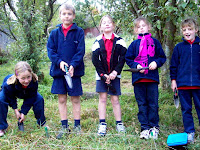







Photography by Georgia
One day Room 15 got some black and white and yellow monarch caterpillars, they were very brightly coloured. After 5 or 6 days the biggest one started hanging upside down in a J shape and then he turned into a chrysalis! The chrysalis was gold, green and black. In a few days it became see-through and we saw the monarch butterfly through the chrysalis. Then after morning tea when we came back inside he started hatching! When he first came outside of the chrysalis his wings were mall and shriveled but after a little bit his wings became bigger. Then he started opening and closing his wings while he opened and closed his tongue. Then we set him free.
By Fiona
The Monarch butterfly lays her eggs and then she dies, then a baby caterpillar hatches out of the egg. The baby caterpillar eats and eats and then the caterpillar goes into a chrysalis. About ten days later the chrysalis hatches into a monarch butterfly. (Go back to the start.)
By Sophie
Monarch Butterflies start their life as a small white egg which the Monarchs lay. When the caterpillar hatches out it eats the egg shell and then after that it eats and eats and eats. The caterpillar grows but its skin does not so the caterpillar has to shed its skin. After eating all the swan plants leaves off it sheds its skin for the last time. This time the caterpillar has a chrysalis underneath. It waits and waits and then it becomes clearer. Soon it will crack open the chrysalis and out will come a shriveled butterfly. The butterfly will pump its wings- this is so the blood will pump into its wings so that it can fly away.
By Holly
In Room 15 we have a swan plant. We started with tiny ,tiny eggs then we saw lots of tiny caterpillars. Over every night they got bigger. When they got big enough they turned themselves into a J shape. The next day they turned into a chrysalis. They stayed more than a week in their chrysalis then they hatched out and they're no longer a caterpillar, they've turned into a monarch butterfly! This year we've let go 6 monarch butterflies. It took weeks to make this happen. The life cycle of the monarch butterfly goes like this: egg, caterpillar, chrysalis, butterfly. By Charlie
When the Monarch hatches its wings are crumpled up like a ball of grass. Sometimes it takes about an hour to get out of the chrysalis. Its wings slowly dry out, pumping green blood through them. At first the butterfly's wings are damp and soft then they dry out and turn hard.
by Jessica N





































 The Gum emperor caterpillar turns into a moth not a butterfly. When it is a caterpillar it is spiky. It turns pink before it turns into a pupa. If you don't know what that is, it is a cocoon. When it becomes a moth it looks nothing like the caterpillar at all. The moth has 5 colours: orange, black, yellow, skin colour and white. Most gum emperors live in the North Island and north of the South Island.
The Gum emperor caterpillar turns into a moth not a butterfly. When it is a caterpillar it is spiky. It turns pink before it turns into a pupa. If you don't know what that is, it is a cocoon. When it becomes a moth it looks nothing like the caterpillar at all. The moth has 5 colours: orange, black, yellow, skin colour and white. Most gum emperors live in the North Island and north of the South Island.